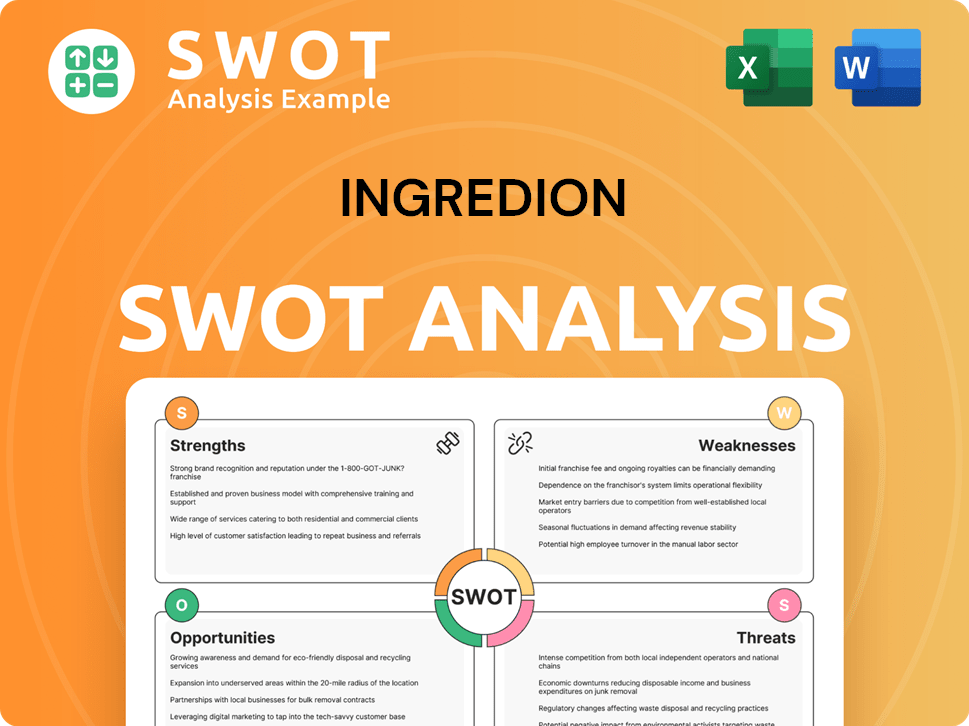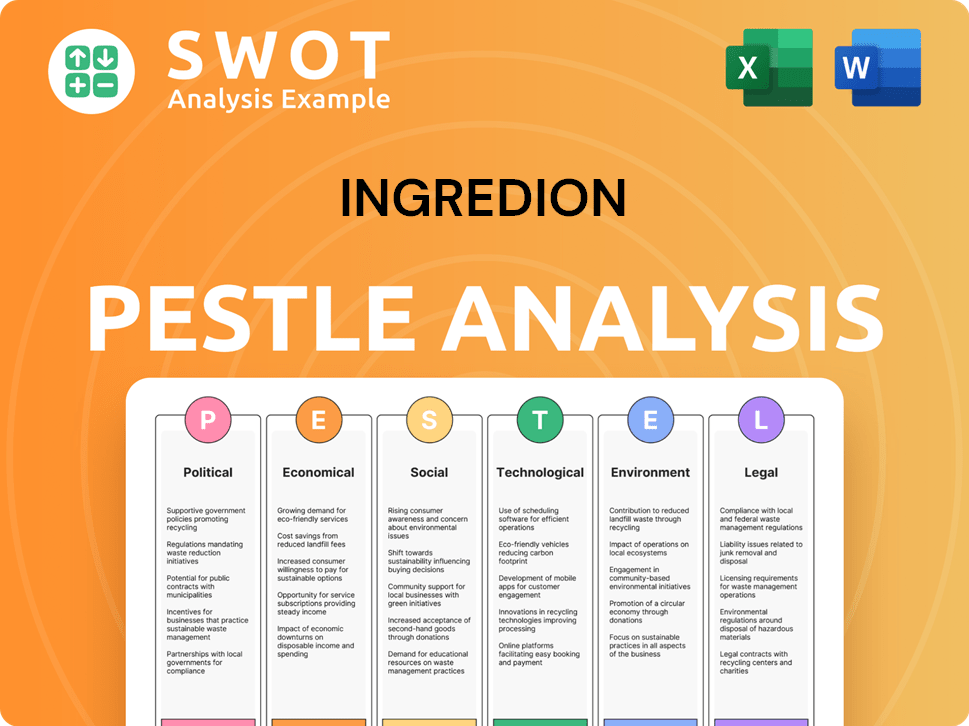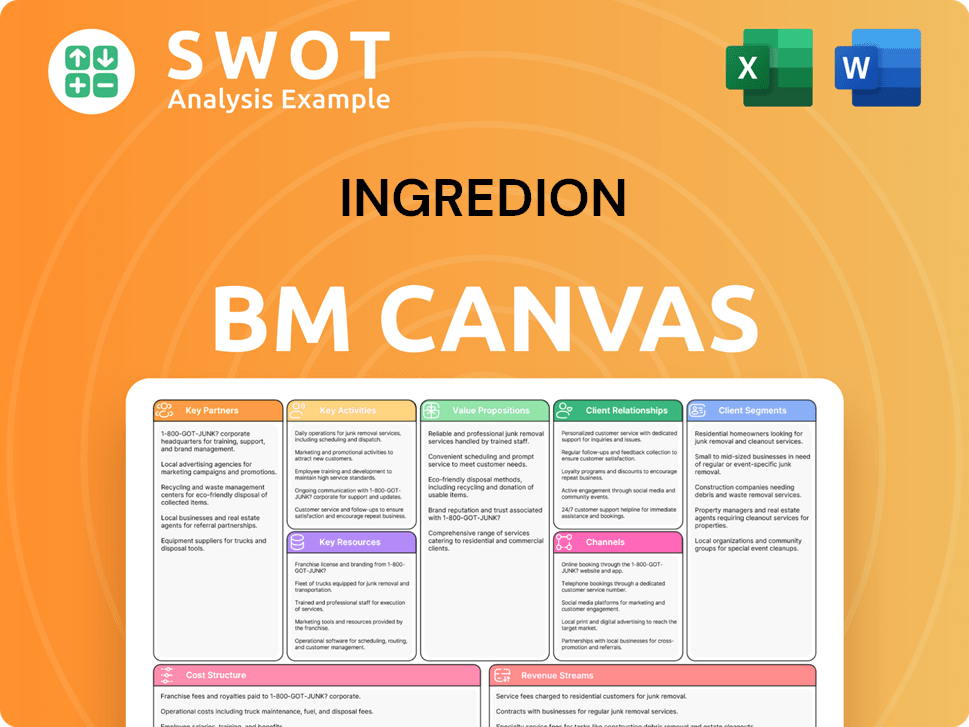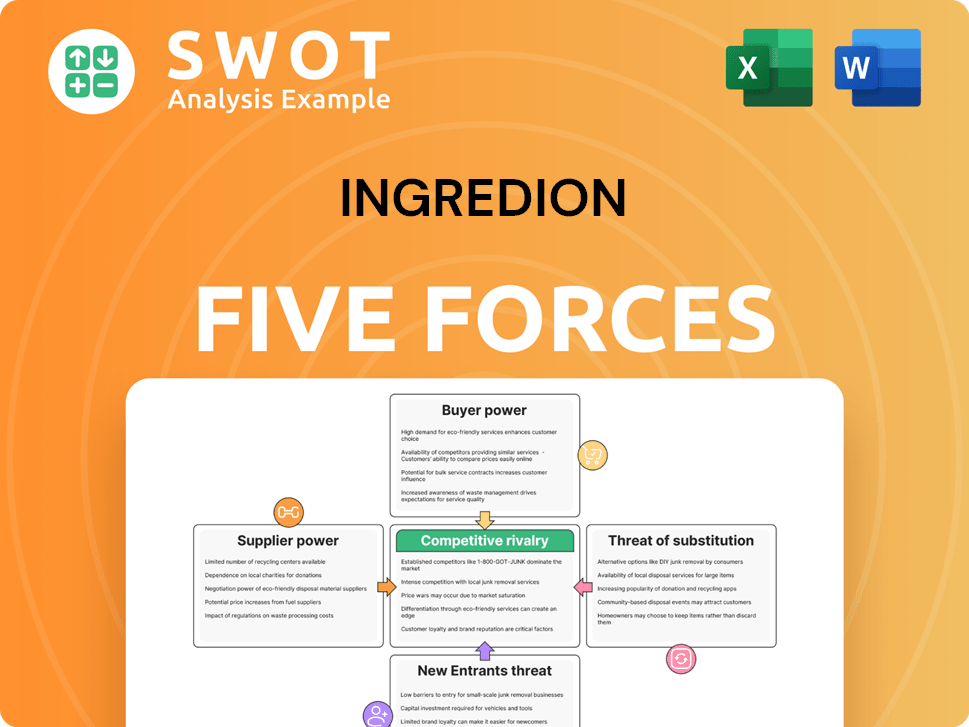Ingredion Bundle
How Did Ingredion Become a Global Ingredient Powerhouse?
Ingredion's story began over a century ago, evolving from a 1906 merger that shaped the U.S. corn refining landscape. Initially known as the Corn Products Refining Company, it set the stage for a global ingredient solutions leader. This Ingredion SWOT Analysis can shed further light on its strategic position.

From its early focus on corn-based products, Ingredion has transformed into a major ingredient supplier, serving diverse markets worldwide. With annual net sales of approximately $7.4 billion as of 2024, the company's journey exemplifies continuous innovation. Understanding the Ingredion history reveals its adaptability and commitment to the evolving food ingredients industry and the role of corn starch.
What is the Ingredion Founding Story?
The Ingredion story begins in 1906 with the establishment of the Corn Products Refining Company. This marked the consolidation of several leading corn refiners in the United States. E.T. Bedford, the inaugural chairman, spearheaded this initiative.
The company was incorporated in New Jersey. Its foundational business model revolved around wet milling and processing corn to produce crucial ingredients for various applications. The early product range included ARGO laundry starch, introduced in 1908, and MAZOLA refined corn oil, first trademarked in 1911. The construction of the Argo corn refining plant in Bedford Park, Illinois, commenced during this period, which remains the company's largest facility.
The early 1900s were characterized by industrial expansion and a rising demand for processed food ingredients, significantly influencing the company's formation and its focus on corn refining. For more insights, you can explore Owners & Shareholders of Ingredion.
Ingredion's early years were marked by strategic mergers and a focus on corn processing.
- 1906: Corn Products Refining Company is formed, the precursor to Ingredion.
- 1908: ARGO laundry starch is introduced.
- 1911: MAZOLA refined corn oil is trademarked.
- The company's initial focus was on wet milling and processing corn.
Ingredion SWOT Analysis
- Complete SWOT Breakdown
- Fully Customizable
- Editable in Excel & Word
- Professional Formatting
- Investor-Ready Format

What Drove the Early Growth of Ingredion?
The early growth of the Corn Products Refining Company, now known as Ingredion, was marked by rapid expansion and diversification. This period saw the company establish a significant global footprint and broaden its product offerings. Key acquisitions and strategic moves during this time laid the foundation for Ingredion's future as a leading ingredient supplier.
By the early 1900s, the company began expanding into Europe. This strategic move was crucial in establishing its global presence. This early internationalization set the stage for future growth and diversification in the food ingredients market.
A notable early acquisition was National Starch, which was later divested and then reacquired. In 1919, Corn Products acquired Canada Starch Company, now known as Casco. The company also received a patent for crystalline dextrose, marketed as CERELOSE®, and introduced BOSCO chocolate-flavored malt syrup.
The 1920s saw further international expansion, with refining operations established in Argentina, Brazil, and Mexico. This expansion demonstrated the company's commitment to becoming a global leader in the food ingredients sector. These moves helped solidify its position in the food industry.
In 1958, the company merged with The Best Foods, Inc., becoming Corn Products Company, and later changed its name to CPC International Inc. in 1969. This period also included expansion into high-fructose corn syrup production and entry into new markets such as Chile, Pakistan, and Malaysia. To understand more, explore the Marketing Strategy of Ingredion.
Ingredion PESTLE Analysis
- Covers All 6 PESTLE Categories
- No Research Needed – Save Hours of Work
- Built by Experts, Trusted by Consultants
- Instant Download, Ready to Use
- 100% Editable, Fully Customizable

What are the key Milestones in Ingredion history?
The Ingredion history is marked by significant milestones, strategic acquisitions, and a commitment to innovation. From its early beginnings, the company has evolved into a leading ingredient supplier, shaping the food industry through its diverse product portfolio and global presence.
| Year | Milestone |
|---|---|
| 1920s | Patent granted for crystalline dextrose, a key early innovation. |
| 2010 | Acquisition of National Starch for $1.3 billion, broadening the product range and geographic reach. |
| 2012 | Corn Products International was renamed Ingredion, reflecting its expanded role. |
| 2014 | Launched global network of Idea Labs® Innovation Centers to collaborate with customers. |
| 2015 | Acquired Penford Corp for $340 million and Kerr Concentrates. |
| 2017 | Acquired TIC Gums. |
| 2020 | Acquired PureCircle Limited, a leading stevia sweetener producer. |
Ingredion has consistently focused on innovation to meet evolving consumer demands. A major innovation was the patent for crystalline dextrose in the 1920s, and more recently, the launch of the stevia-based ENLITEN® brand of high-intensity, low-calorie sweeteners.
The patent for crystalline dextrose was a significant early innovation, marking a step forward in the company's history of corn processing. This innovation helped establish Ingredion as a key player in the food ingredients market.
The ENLITEN® brand represents Ingredion's innovation in high-intensity, low-calorie sweeteners. This launch reflects the company's response to changing consumer preferences for healthier food options.
Launched in 2014, these centers facilitate collaboration with customers on science-based solutions. As of 2021, over 500 scientists were working across 32 locations within the Idea Labs® network.
Strategic acquisitions like National Starch, Penford Corp, Kerr Concentrates, TIC Gums, and PureCircle Limited have broadened Ingredion's product portfolio and geographic reach. These acquisitions have enhanced the company's capabilities in food ingredients.
Ingredion has faced challenges including fluctuating raw material costs and competitive pressures. Despite these, Ingredion has demonstrated resilience, achieving record gross profit levels.
Fluctuations in the cost of raw materials, such as corn starch, pose a significant challenge. Managing these costs effectively is crucial for maintaining profitability and competitiveness.
The food ingredients market is highly competitive, requiring continuous innovation and efficiency. The company faces competition from other ingredient suppliers.
Changing consumer preferences, such as the demand for healthier and sustainable products, require Ingredion to adapt. The company must innovate to meet these evolving demands.
Ingredion achieved record gross profit levels of $1.8 billion in 2024 with margins of 24%. This was partly due to effective cost management through initiatives like the Cost2Compete program.
Ingredion is committed to sustainability, with goals to sustainably source 100% of its Tier 1 priority crops by the end of 2025. This reflects the company's dedication to environmental responsibility.
Ingredion Business Model Canvas
- Complete 9-Block Business Model Canvas
- Effortlessly Communicate Your Business Strategy
- Investor-Ready BMC Format
- 100% Editable and Customizable
- Clear and Structured Layout

What is the Timeline of Key Events for Ingredion?
The Ingredion story began in 1906 with the formation of Corn Products Refining Company, marking the start of a journey that would transform the ingredient supplier landscape. Over the years, the company has evolved through mergers, acquisitions, and name changes, consistently innovating in the food ingredients sector. From the introduction of ARGO laundry starch in 1908 to the launch of Ingredion Idea Labs® Innovation Centers, the company has adapted to meet changing consumer demands and industry trends. Acquisitions like National Starch, Penford Corp, TIC Gums, PureCircle Limited, Verdient Foods, and KaTech have broadened its portfolio and global presence, reinforcing its commitment to providing innovative ingredient solutions.
| Year | Key Event |
|---|---|
| 1906 | Corn Products Refining Company is formed through the merger of leading U.S. corn refiners. |
| 1908 | ARGO laundry starch is introduced. |
| 1911 | MAZOLA is first used as a trademark for refined corn oil. |
| 1919 | Corn Products acquires Canada Starch Company. |
| 1923 | Corn Products receives a patent for crystalline dextrose (CERELOSE®). |
| 1958 | Corn Products Refining Company merges with The Best Foods, Inc., becoming Corn Products Company. |
| 1969 | The company changes its name to CPC International Inc. |
| 1997 | Corn Products International spins off from CPC International. |
| 2010 | Corn Products International acquires National Starch for $1.3 billion. |
| 2012 | Corn Products International changes its name to Ingredion. |
| 2014 | Ingredion Idea Labs® Innovation Centers are launched globally. |
| 2015 | Ingredion acquires Penford Corp for $340 million and Kerr Concentrates for $100 million. |
| 2017 | Ingredion acquires TIC Gums. |
| 2020 | Ingredion acquires PureCircle Limited, a stevia sweetener maker, and Verdient Foods. |
| 2021 | Ingredion acquires KaTech, a German manufacturer of texture and stabilization solutions. |
| 2024 | Ingredion reorganizes into new segments: Texture & Healthful Solutions and Food & Industrial Ingredients. |
| 2025 | Ingredion expects full-year reported EPS in the range of $10.93 to $11.63 and adjusted EPS between $10.90 and $11.60. |
In 2025, Ingredion anticipates full-year reported earnings per share (EPS) between $10.93 and $11.63, with adjusted EPS ranging from $10.90 to $11.60. Net sales are projected to increase in the low single-digits, indicating continued growth in the food ingredients market. These figures reflect the company's strategic initiatives and its ability to navigate market dynamics.
Ingredion is focused on sustainable ingredient solutions and enhancing customer product performance. The company aims for low single-digit net sales growth in Q2 2025 and mid-single-digit to high single-digit operating income growth in its Texture & Healthful Solutions segment for the full year. This strategy underscores its commitment to innovation and market leadership.
Ingredion is dedicated to sustainable sourcing, aiming to sustainably source 100% of its Tier 1 priority crops by the end of 2025. This commitment highlights the company's focus on environmental responsibility and its role in the food supply chain. This initiative supports the company’s long-term sustainability goals.
For full-year 2025, capital expenditures are expected to be approximately $400 million to $450 million. Cash from operations is projected to be in the range of $825 million to $950 million. These investments support Ingredion's ongoing innovation and expansion, ensuring its ability to meet market demands and enhance its position as a leading ingredient supplier.
Ingredion Porter's Five Forces Analysis
- Covers All 5 Competitive Forces in Detail
- Structured for Consultants, Students, and Founders
- 100% Editable in Microsoft Word & Excel
- Instant Digital Download – Use Immediately
- Compatible with Mac & PC – Fully Unlocked

Related Blogs
- What is Competitive Landscape of Ingredion Company?
- What is Growth Strategy and Future Prospects of Ingredion Company?
- How Does Ingredion Company Work?
- What is Sales and Marketing Strategy of Ingredion Company?
- What is Brief History of Ingredion Company?
- Who Owns Ingredion Company?
- What is Customer Demographics and Target Market of Ingredion Company?
Disclaimer
All information, articles, and product details provided on this website are for general informational and educational purposes only. We do not claim any ownership over, nor do we intend to infringe upon, any trademarks, copyrights, logos, brand names, or other intellectual property mentioned or depicted on this site. Such intellectual property remains the property of its respective owners, and any references here are made solely for identification or informational purposes, without implying any affiliation, endorsement, or partnership.
We make no representations or warranties, express or implied, regarding the accuracy, completeness, or suitability of any content or products presented. Nothing on this website should be construed as legal, tax, investment, financial, medical, or other professional advice. In addition, no part of this site—including articles or product references—constitutes a solicitation, recommendation, endorsement, advertisement, or offer to buy or sell any securities, franchises, or other financial instruments, particularly in jurisdictions where such activity would be unlawful.
All content is of a general nature and may not address the specific circumstances of any individual or entity. It is not a substitute for professional advice or services. Any actions you take based on the information provided here are strictly at your own risk. You accept full responsibility for any decisions or outcomes arising from your use of this website and agree to release us from any liability in connection with your use of, or reliance upon, the content or products found herein.